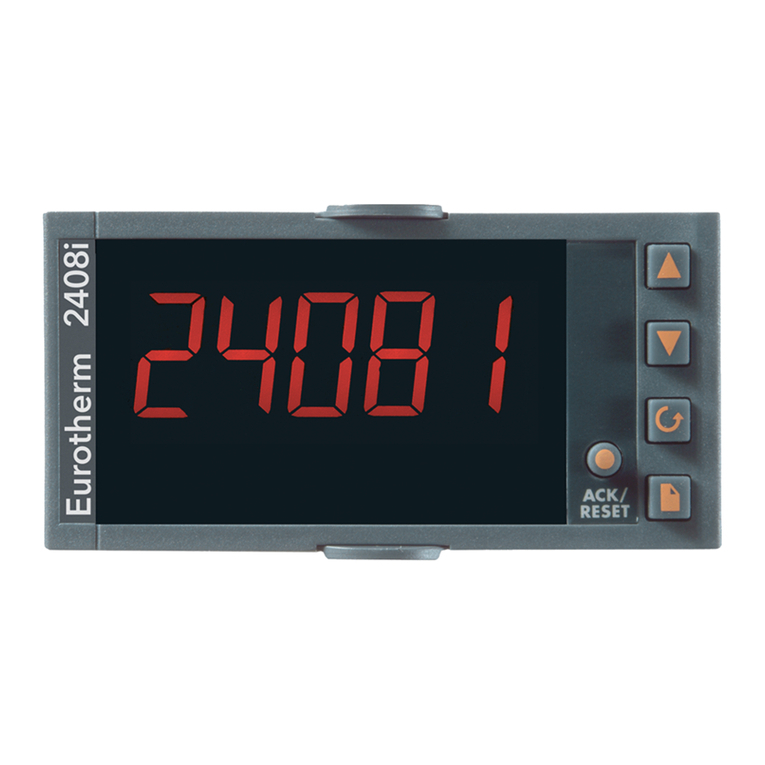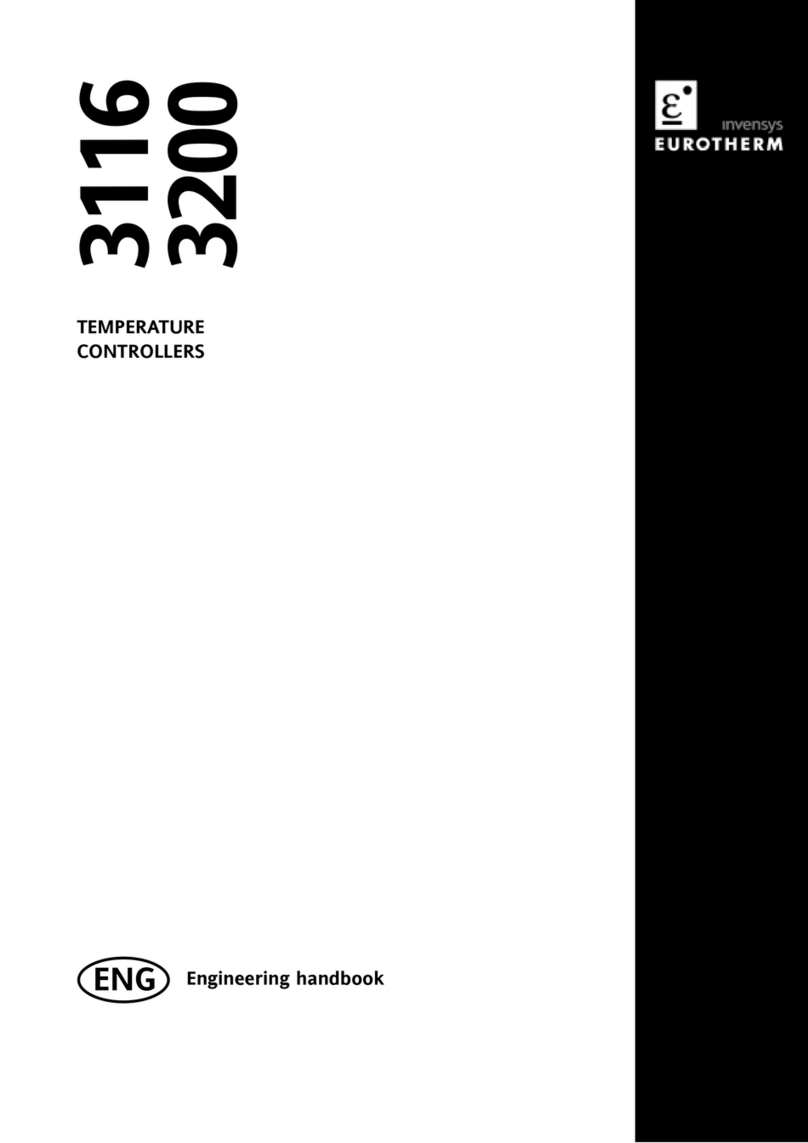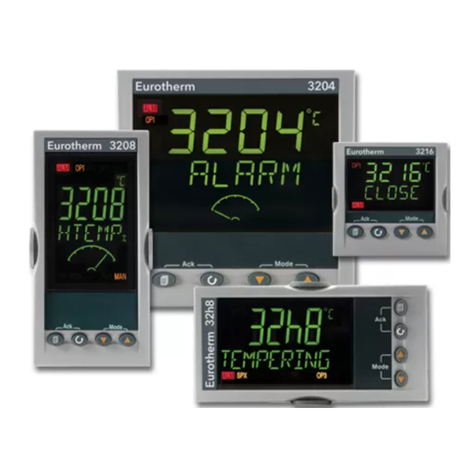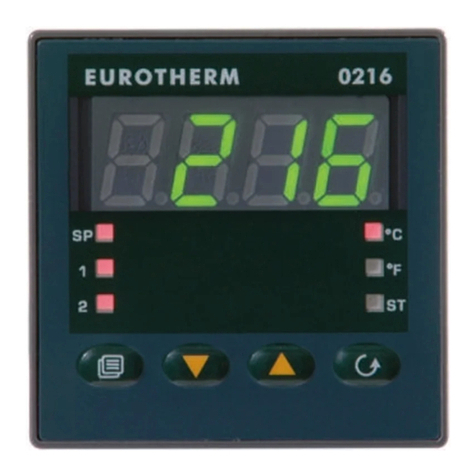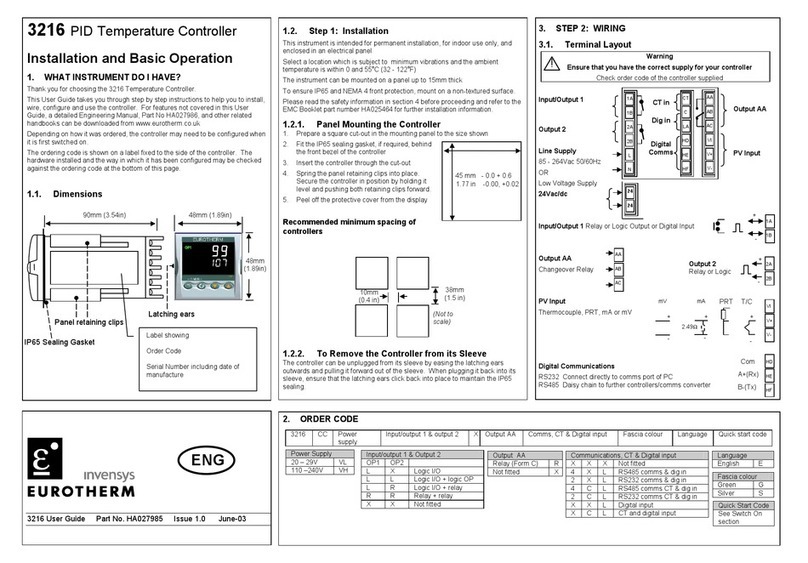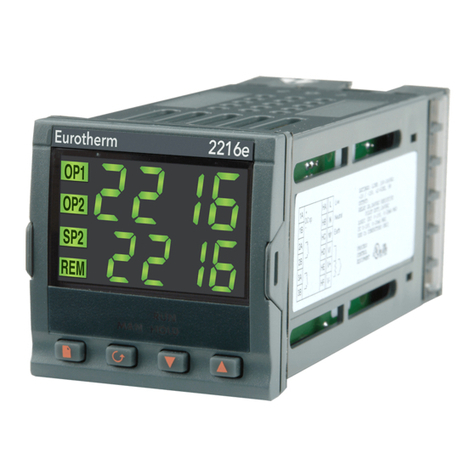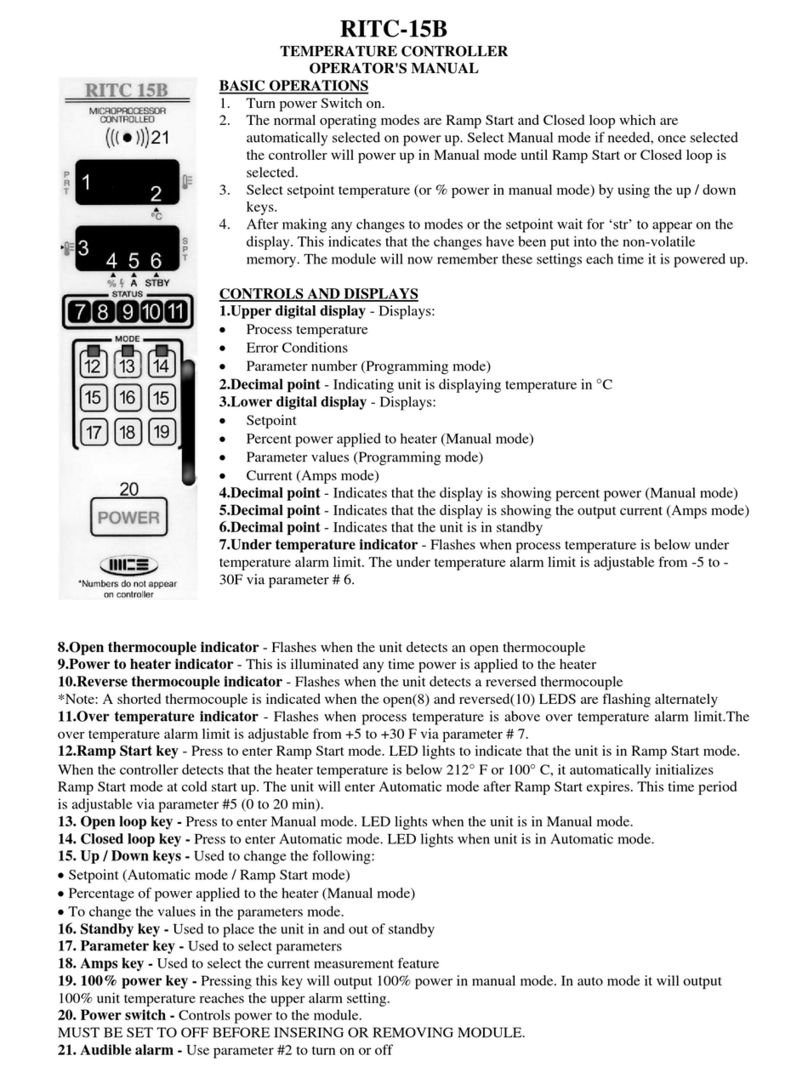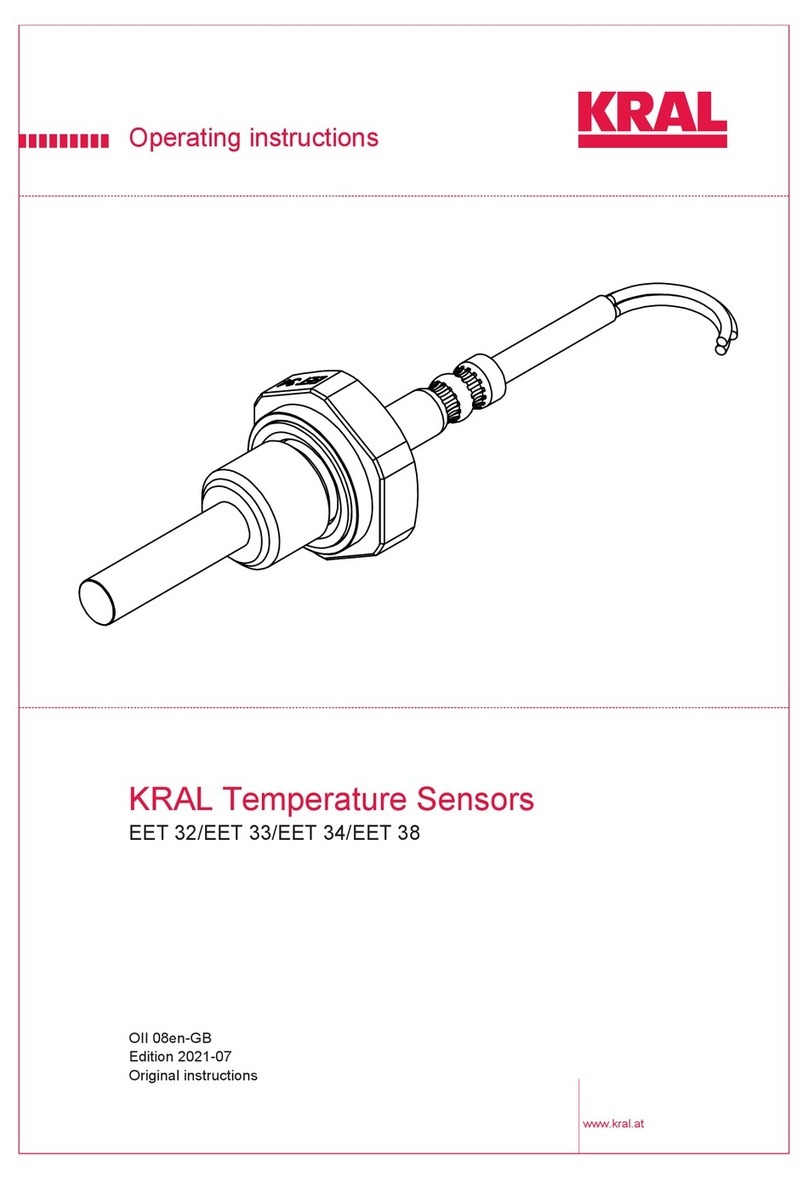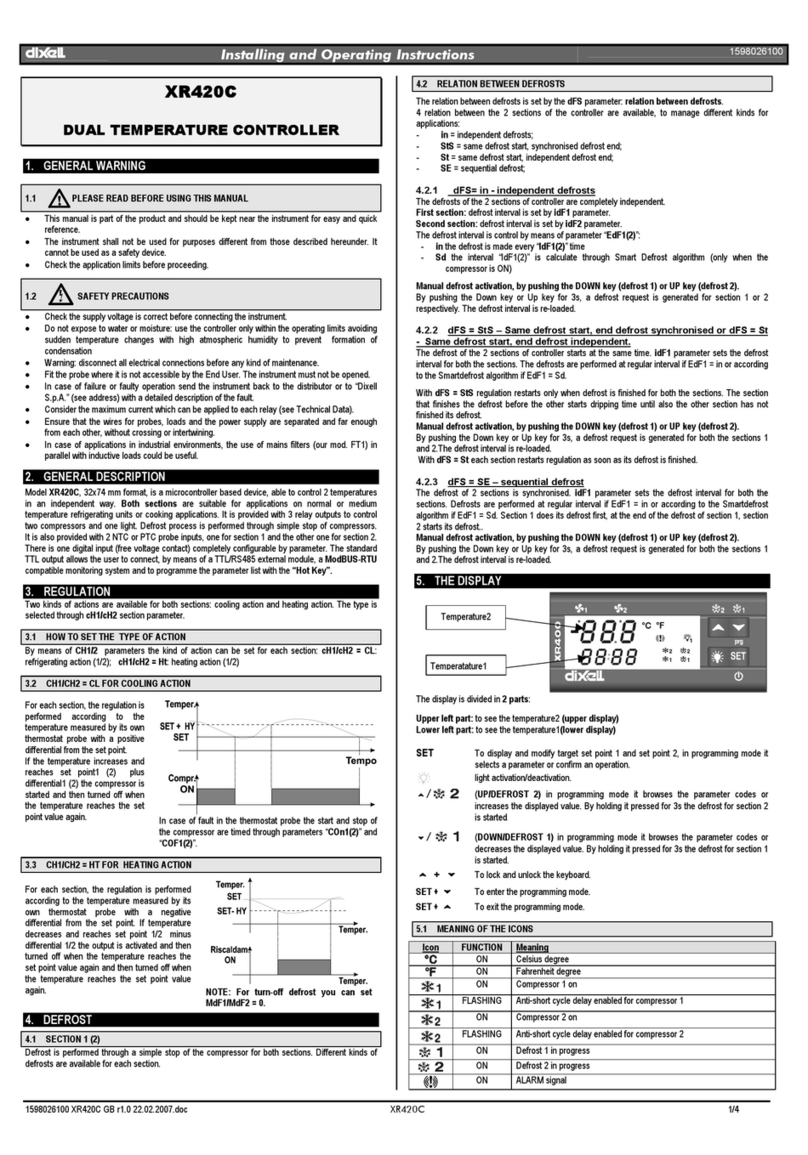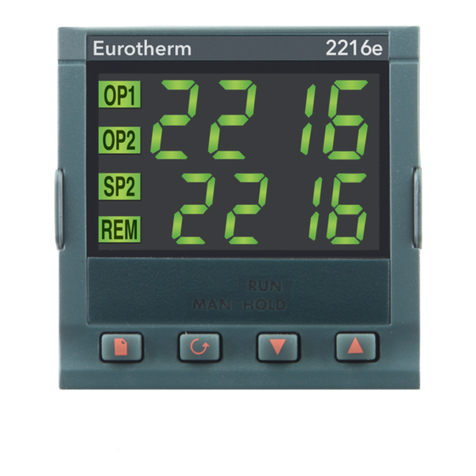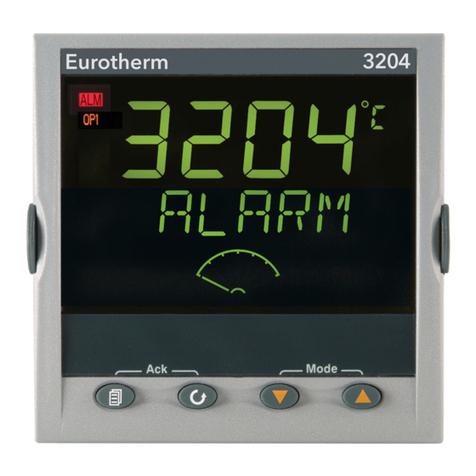
6. OPERATOR LEVELS
Operator level 1 is designed for day to day operation of the controller and is not
protected by a security code.
Level 2 provides access to additional parameters and access is protected by a
security code.
6.1. To Enter Level 2
From any display press and hold .
After a few seconds the display will show ‘Lev 1Goto ’.
Release .
(If a button is not pressed for 20 seconds the display returns
to the HOME display)
Press or to choose Lev 2
Press or to enter the correct code
By default this is set to ‘2’
If an incorrect code is entered the display reverts to the
HOME display
6.1.1. To Return to Level 1
Press and hold
Press to select LEV1.
It is not necessary to enter a code when going from a higher level to a lower level.
When Level 1 is selected the display reverts to the HOME display
6.2. Level 1 & 2 Parameters
Press to scroll through the list of parameters. The mnemonic of the
parameter is shown in the lower display, followed once by a scrolling help
message showing a longer description of the parameter.
The value of the parameter is shown in the upper display.
Press or to adjust.
If no key is pressed for a few seconds the display returns to ‘HOME’
WKG.SP* WORKING SETPOINT is the current target setpoint. It may be
derived from SP1 or SP2, or, if the controller is ramping (see
SP.RAT), it is the current ramp value.
WRK.OP* WORKING OUTPUT is the output from the controller
expressed as a percentage of full output. Range –100% (Max
cooling) to +100% (max heating).
For a time proportioning output, 50% = relay or logic output on
or off for equal lengths of time.
For an On/Off output 0 to <1% = output off, >1 to 100% =
output on
T.STAT TIMER STATUS is only shown if a timer is configured. Allows
the timer to be put into Run, Hold or Reset mode.
UNITS DISPLAY UNITS can be selected from oC, oF, oK, PERC
(percent), none
SP.HI and
SP.LO
SETPOINT HIGH applies a high limit to SP1 and SP2
SETPOINT LOW applies a low limit to SP1 and SP2
SP1* and
SP2*
SETPOINT 1 to adjust the value of the setpoint 1
SETPOINT 2 to adjust the value of the setpoint 2
SP.RAT SETPOINT RATE LIMIT sets the rate of change of setpoint.
Limits the rate of heating or cooling.
TI.CFG TIMER CONFIGURATION configures the timer type - Dwell,
Delay, Soft Start or none (only when in Reset)
TM.RES TIMER RESOLUTION selects hours or minutes (only when in
Reset)
THRES TIMER START THRESHOLD The timer will not run until the
PV becomes in range of the value set by this parameter. This
value can be changed when the timer is running.
END.T TIMER END TYPE The action of the timer when it has timed
out can be selected from Dwell (control continues at the
setpoint), Off (control outputs turn off), SP2 (control at setpoint
2). Can be changed while the timer is running.
DWELL* SET TIME DURATION - can be adjusted while the timer is
running.
T.REMN TIME REMAINING
SS.PWR SOFT START POWER LIMIT
SS.SP TIMER SOFT START THRESHOLD
A1.--- -*
to A4.---*
ALARM 1 (2, 3 or 4) SETPOINT sets the threshold value at
which an alarm is detected. Up to four alarms are available
and are only shown if configured.
--- = the mnemonic for the alarm type which may be:-
Lo Full Scale Low Bnd Deviation Band
Hi Full Scale High dLo Deviation Low
dHi Deviation High
AI.LAT to
A4.LAT
ALARM 1 (2, 3 or 4) LATCH TYPE is used to latch the alarm
condition once an alarm has been detected. It may be
configured as:-
None Non latching: The alarm will only be active
when an alarm condition persists.
If the alarm is still present when acknowledged,
the alarm beacon will stay on. An output (relay)
associated with this alarm will remain active.
Auto Automatic: The alarm continues to be active
until both the alarm condition is removed AND
the alarm is acknowledged. The
acknowledgement can occur BEFORE the
condition causing the alarm is removed.
Man Manual: The alarm continues to be active until
both the alarm condition is removed AND the
alarm is acknowledged. The acknowledgement
can only occur AFTER the condition causing the
alarm is removed.
Evnt Event: No alarm indication
A1.HYS
to
A4.HYS
ALARM 1 (2, 3 or 4) HYSTERESIS is the difference between
the point at which the alarm switches ‘ON’ and the point at
which it switches ‘OFF’. It is used to provide a positive
indication of the alarm condition and to prevent alarm relay
chatter.
A1.BLK to
A4.BLK
ALARM 1 (2, 3 or 4) BLOCKING – the alarm only occurs after
the start up of the process when the alarm has first entered a
safe state. The alarm is only indicated the next time it is active.
Select YES to enable, No to disable.
A.TUNE* AUTOTUNE automatically sets the control parameters to
match the process characteristics.
PB PROPORTIONAL BAND sets an output which is proportional
to the size of the error signal. Units may be % or display units.
TI INTEGRAL TIME removes steady state control offsets by
ramping the output up or down in proportion to the amplitude
and duration of the error signal.
TD DERIVATIVE TIME determines how strongly the controller will
react to the rate of change in the process value. It is used to
prevent overshoot and undershoot and to restore the PV rapidly
if there is a sudden change in demand.
HYST.H HEATING HYSTERESIS sets the difference in PV units
between the output (relay) turning off and turning on.
Only shown if the control action is On/Off.
MR MANUAL RESET applies to a PD only controller i.e. the
integral term is turned off. Set this to a value of power output
(from +100% heat, to -100% cool) which removes any steady
state error between SP and PV.
R2G RELATIVE COOL GAIN adjusts the cooling proportional band
relative to the heating proportional band. Particularly
necessary if the rate of heating and rate of cooling are very
different. Heat/Cool controller only.
D.BAND CHANNEL 2 DEADBAND adjusts a zone between heating and
cooling outputs when neither output is on. Off = no deadband.
100 = heating and cooling off. On/Off controllers only.
OP.HI OUTPUT HIGH limits the maximum heating power applied to
the process or a minimum cooling output.
LBT LOOP BREAK TIME allows a time to be set before a loop
break alarm is initiated. A loop break is signalled if the PV
does not move towards the setpoint after the power has been
saturated for the loop break time. For an On/Off controller LBT
is not shown and loop break alarm is inhibited.
1.PLS,
2.PLS,
4.PLS
OUTPUT 1 (2 or 4) MINIMUM PULSE TIME when the output
operates it remains on for a time set by this parameter. Relay
outputs are adjustable from 0.1 to 150 seconds. Logic outputs
set to Auto = 55ms.
LD.AMP*
This section applies to current transformer input only.
LOAD CURRENT is the measured load current when the
power demand is on.
LK.AMP LEAK CURRENT is the measured leakage current when the
power demand is off.
LD.ALM - LOAD CURRENT THRESHOLD sets a low alarm trip point for
the load current as measured by the CT. This detects partial
load failure.
LK.ALM LEAK CURRENT THRESHOLD sets a high alarm trip point for
the leakage current as measured by the CT.
HC.ALM OVERCURRENT THRESHOLD sets a high alarm trip point to
show over current as measured by the CT
ADDR
This section applies to digital communications only.
ADDRESS - communications address of the controller. 1 to
254
HOME HOME DISPLAY defines the parameter which appears in the
lower section of the HOME display when the controller is in
Operator Level. This can be selected from:- Std (Standard),
OP (Output Power), Ct (Current), AL1 (Alarm 1), tr (Time
Remaining), ELAP (Time Elapsed – when Timer is configured),
CLr (Clear – lower display blank), tmr (combined setpoint and
time display)
Note Standard is the default which shows Setpoint in Auto or
Output in Manual.
ID CUSTOMER ID is a number from 0 to 9999 entered as a
customised identification number for the controller
REC.NO CURRENT RECIPE NUMBER selects a recipe from none, 1,
2, 3, 4, or 5 – the most frequently used parameters can be
stored in a recipe. .
STORE RECIPE TO SAVE current parameter values can be saved to
recipe numbers 1, 2, 3, 4, or 5 (or none)
* Available in Level 1 and level 2
0.5sec

